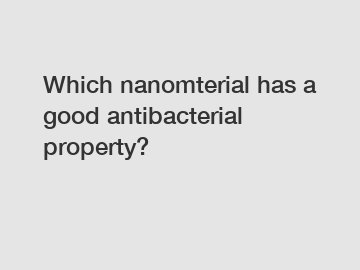Which nanomterial has a good antibacterial property?
Ruisen Product Page
Which Nanomaterial Has a Good Antibacterial Property?
Over the years, scientists and researchers have been exploring the potential of nanomaterials in various fields, including medicine and healthcare. One area of particular interest is their antibacterial properties. Nanomaterials, which possess unique physical and chemical properties at the nanoscale, show promise in combating bacterial infections. In this article, we will delve into the world of nanomaterials to understand which ones exhibit excellent antibacterial properties and how they can potentially revolutionize medicine.

Point 1: Silver Nanoparticles.
One of the most extensively studied nanomaterials for its antibacterial abilities is silver nanoparticles. These particles have proven to be potent against a wide range of bacteria, including both Gram-positive and Gram-negative strains. The unique characteristic of silver nanoparticles lies in their ability to destroy bacterial cells by damaging their cell walls and membranes. Moreover, silver nanoparticles have demonstrated the ability to inhibit bacterial growth and prevent the formation of biofilms, which are highly resistant to antibiotics.
Point 2: Zinc Oxide Nanoparticles.
Zinc oxide nanoparticles have also emerged as a promising antibacterial agent. These nanoparticles possess numerous advantages, such as low cost, ease of synthesis, and minimal toxicity to human cells. Research has shown that zinc oxide nanoparticles can effectively inhibit the growth of various bacteria, including those associated with medical infections. Furthermore, they have been found to disrupt bacterial cell functions by generating reactive oxygen species (ROS) that can lead to cell death.
Point 3: Copper Nanoparticles.
Copper nanoparticles have gained attention for their remarkable antibacterial properties. These nanoparticles have the ability to penetrate bacterial cells and interfere with their vital processes, making them an effective antibacterial agent. Additionally, copper nanoparticles have demonstrated broad-spectrum activity against drug-resistant bacteria. Notably, copper has been used for centuries for its antimicrobial effects, and its nanoparticle form further enhances these properties.
Point 4: Titanium Dioxide Nanoparticles.
Titanium dioxide nanoparticles have shown great potential as a photocatalyst with antibacterial properties. When exposed to ultraviolet (UV) light, titanium dioxide nanoparticles can generate free radicals, which can damage bacterial cells and hinder their growth. Interestingly, this photocatalytic effect can be activated by both sunlight and artificial light sources, making it suitable for a wide range of applications. However, further research is needed to optimize their antibacterial activity and ensure their safety for use in medical settings.
Point 5: Chitosan Nanoparticles.
Chitosan, derived from chitin found in the exoskeleton of crustaceans, is a biocompatible and biodegradable nanomaterial that possesses antibacterial properties. Chitosan nanoparticles have shown efficacy against various bacteria, including both drug-sensitive and drug-resistant strains. The mechanism behind their antibacterial activity involves disrupting the cell walls and membranes of bacteria, leading to cell death. Chitosan nanoparticles have great potential for applications in wound healing, drug delivery systems, and antimicrobial coatings.
In conclusion, nanomaterials have opened up new possibilities in the field of antibacterial research. The four main types of nanomaterials discussed – silver nanoparticles, zinc oxide nanoparticles, copper nanoparticles, and titanium dioxide nanoparticles – all possess unique properties that make them effective against bacteria. Additionally, chitosan nanoparticles derived from crustaceans exhibit impressive antibacterial properties. Although these nanomaterials have shown great promise, further studies are required to optimize their effectiveness and evaluate their long-term safety. The future of antibacterial treatments may lie in the realm of nanotechnology, offering new hope in the battle against bacterial infections.
If you are looking for more details, kindly visit our website.
Are you interested in learning more about nano silver powder supplier? Contact us today to secure an expert consultation!



